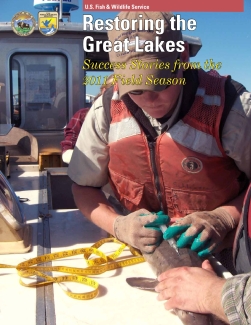
Now in its second year, the Great Lakes Restoration Initiative continues to make great strides in the protection and restoration of the Great Lakes. An invaluable resource to the United States as a source of drinking water, transportation, power, recreational opportunities and jobs, the Great Lakes remain a conservation priority for the federal government. Though a tough economic climate can jeopardize conservation priorities, research has demonstrated that the health of the Great Lakes is inseparable from the health of the U.S. economy. A 2011 Michigan Sea Grant report found the Great Lakes support more than 1.5 million jobs and are a source for more than $62 billion in wages.
Perched between the United States and Canada and touching the shores of eight states and many tribal lands, the Great Lakes are an expansive resource requiring the highest levels of coordination in management activities. The Great Lakes Restoration Initiative continues to take important steps to protect key species, restore areas of concern and better connect wild spaces within the more than 10,000 miles of coastline and 30,000 islands that provide critical habitat to many fish and wildlife species.
As a proud federal partner in implementing the Great Lakes Restoration Initiative, the U.S. Fish and Wildlife Service is excited to share with you our success stories from the 2011 field season. Through an interagency agreement with the U.S. Environmental Protection Agency, the Service received more than $48 million in funding to reduce toxic substances, restore critical habitat, protect wildlife and prevent the movement of invasive species invasive species
An invasive species is any plant or animal that has spread or been introduced into a new area where they are, or could, cause harm to the environment, economy, or human, animal, or plant health. Their unwelcome presence can destroy ecosystems and cost millions of dollars.
Learn more about invasive species into and throughout the Great Lakes. In our second edition of Restoring the Great Lakes, we present only a sampling of the amazing work our staff, field teams and project partners have accomplished. Supported by Great Lakes Restoration Initiative funding, their hard work and dedication has resulted in many on-the-ground achievements.
Whether the electricity powering your home is from wildlife-friendly wind energy sources, or the lake trout on the end of your fishing line is from one of our national fish hatcheries, you may be surprised to learn how the work of the U.S. Fish and Wildlife Service in the Great Lakes basin impacts your life. If the studies within this book spark your curiosity, we invite you out to our national wildlife refuges and national fish hatcheries to learn more about the fish and wildlife of the Great Lakes and the people who depend on these resources as a source of income and a way of life. We are already planning our 2012 field season, and look forward to sharing our ongoing Great Lakes Restoration Initiative accomplishments with you.
| Attachment | Size |
|---|---|
| GLRI-Restoring-Great-Lakes-2011.pdf2.38 MB | 2.38 MB |